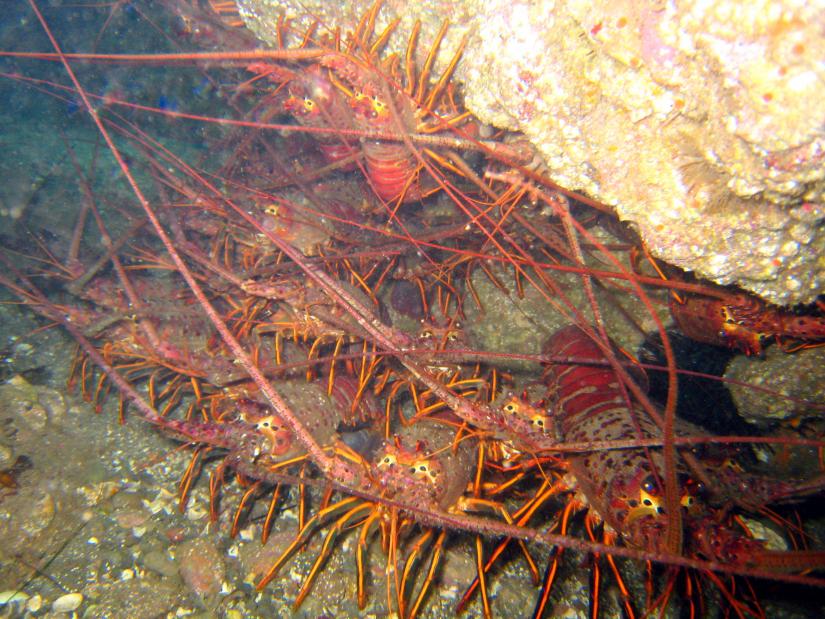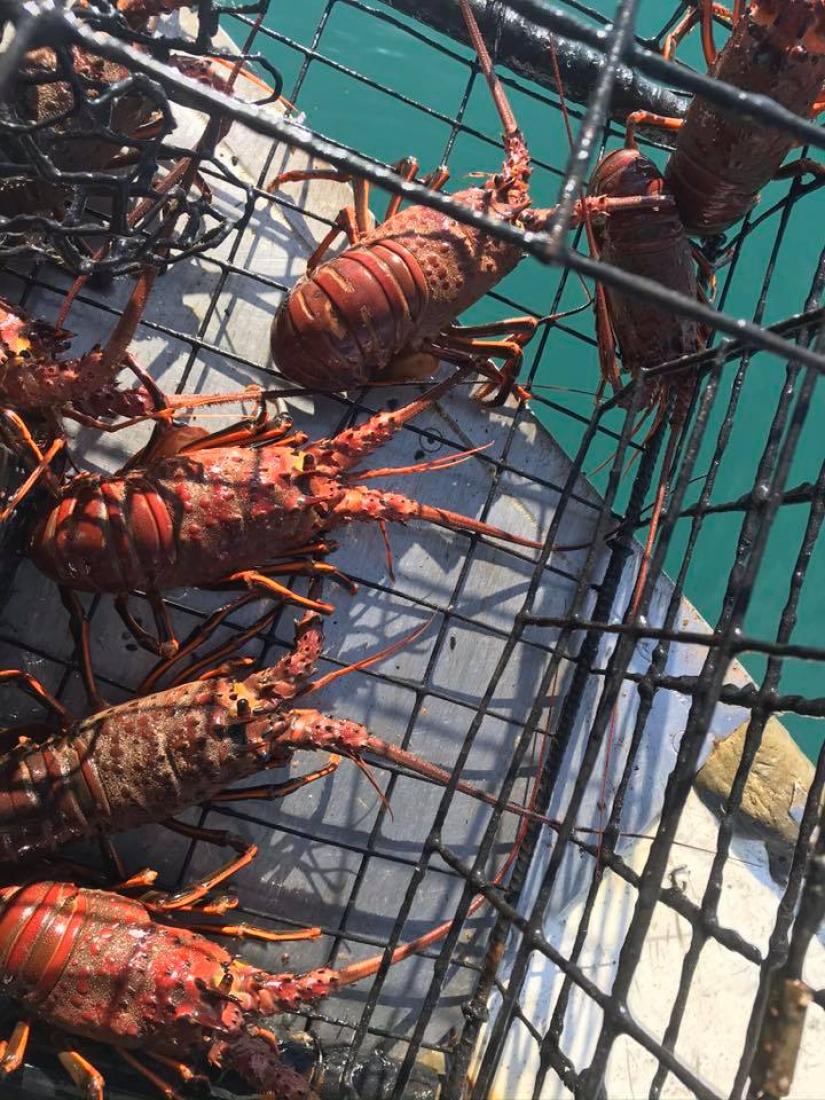California Spiny Lobster
Panulirus interruptus
The Science
THE SCIENCE
The spiny lobster sweeps its antennae, which has an acoustic structure at each base, to create an alarming grating noise that intimidates predators and competitors.

Taxonomic description
- Adults average 1 kg (2 lbs) and 30 cm (12 in) long; can grow to 12 kg (26 lbs), although rarely found over 2.3 kg (5 lbs). [1,2]
- Is a decapod (ten-legged) crustacean with sharp, spiny projections along the upper shell and sides of tail. [1,2]
- Has two antennae twice length of its body, and lacks prominent front claws. [1,2]
- Generally red to orange in color. [1,2]
- Has strong jaws that can deliver powerful bites. [1]
- Swims backwards with a flip of the tail to flee predators, and is able to crawl in all directions. [1]
Distribution
- Found from Monterey Bay, California to Magdalena Bay, Baja California, with very few north of Point Conception. [1]
Life history
- Matures at 5 years; mating occurs between December-March; Spawning occurs once per year from late spring to late summer with most activity between May-July. [1]
- Can live 30-50 years. [2]
- Males attach a gummy packet of sperm on the underside of a female, who may carry from 50,000 - 800,000 eggs on the underside of her tail. [1]
- Eggs are fertilized when the female uses the small claws on the last pair of walking legs to tear open the sperm packet; fertilized eggs stay on the female until they hatch 10 weeks later. [1]
- There are 11 larval stages that drift with prevailing currents and feed on other planktonic animals for up to 10 months; larvae are found from 0-121 m (400 ft) in depth and up to 350 miles offshore. [1]
- The 11th and final larval stage, which looks like a miniature transparent adult, swims toward the coast where it settles in shallow, vegetated, seafloor habitat. [1]
- Grows by molting the exoskeleton; the soft body hardens into new exoskeleton about a day after leaving the old one. [1,2]
- Can regenerate lost legs, antennae with each molt. [1,2]
Habitat
- Adults inhabit rocky areas from the intertidal zones to depths of 70 m (240 feet) or more, sheltered in crevices. [1]
- Often found with surfgrass, eelgrass, and many types of seaweed including large brown kelps and coralline algae. [1]
- Usually concealed during the day, often in groups within a single crevice. [1]
- Starts feeding shortly after sunset and is primarily an omnivorous scavenger. [1,2]
- Undergoes a seasonal migration inshore from June to September, and offshore in winter months. [1]
The Fishery
THE FISHERY
Commercial lobster traps have self-destruction devices that prevent the continued capture of marine life if the trap gets lost.

Seasonal availability
- Available live during open season, early October to mid-March. [3]
- Most readily available in the first half of the season (fall) when fishing effort is closet to shore; winter swells, storms, and colder water drive lobster offshore making it harder to trap. [3]
Regulatory and managing authority
- As established by the Marine Life Management Act, the California Fish and Game Commission regulates the fishery, and the California Department of Fish and Wildlife manages this fishery in state waters through the California Spiny Lobster Fishery Management Plan. [2,3,4]
Gear type
- Rectangular traps made of wire or plastic mesh range from 71 x 91 x 36 cm to 91 x 122 x 51 cm (28"x 36"x 14" to 36"'x 48" x 20").
- Traps are baited with fish and weighted down on the seafloor and around rocky underwater outcrops in water less than 40 m (100 ft) deep. [3,4]
- Limit of 300 traps per permit; one boat may have multiple permits. [3,4]
- An escape port built into trap allows undersized lobsters to freely exit. [3]
Status of the fishery
- The California commercial fishery is predominantly located in the Southern California Bight, from Point Conception to the U.S.-Mexico Border including the islands of off Southern California; this is also a popular hoop-net and dive-based recreational fishery in this region. [3]
- Commercial fishery harvest about 660,000 lbs (300+ metric tons) each season, recreational take adds about 30 to 60% to commercial catch. [3,4]
- The stock is currently stable, and the fishery is considered at low risk of over-exploitation. [3,4]
- Anticipated increases in fishing pressure, the rising popularity and usage of hoop nets in the recreational fishery, and commercial fishery permit transfers may require a reassessment of current management strategies to ensure continued responsible management. [3,4,5]
Potential ecosystem impacts
- Bycatch rate for this fishery is considered low impact as the trap structure enables live release for common incidental species like octopus or sheepshead. [3,5]
- Traps may cause local damage to benthic habitat if they are dragged during storm surges. [5]
- There is a low potential risk to marine mammals via entanglement in trap lines. [5]
The Seafood
THE SEAFOOD
The green tomalley of a lobster, located inside the head, functions much like a liver and is a delicacy, but should be eaten sparingly since it may accumulate toxins.


Edible portions
- Body (excepting gray, feathery gills and sand sac between the eyes). [6]
- Coral (roe) found within the body is a delicacy, but is sensitive to toxins. [6]
- Most meat is located in the tail, some at base of antennae. [6]
- The tail flippers also contain thin strips of meat. [6]
- Sold fresh live and whole, or frozen in raw tails or meat. [7]
- One pound of raw lobster will yield approximately 1/3 pound of cooked meat. [15]
Description of meat
- This lobster has soft-textured meat with delicate, sweet flavor. [7]
Culinary uses
- Popular steamed, barbecued, roasted, or grilled, and is often basted with butter. [6]
- Complements pastas and bisques well. [6]
- Once the meat is removed, the body and legs can be simmered for stock. [6]
- For a recipe for Escovitch Lobster, visit Jamaicans.com. [9]
- For a lobster bisque recipe, visit Taste of Home. [10]
Nutritional information
- Information for one spiny lobster cooked with moist heat is available. [8]
Toxicity report
- Can have low mercury levels, so check consumption guidelines if you are at-risk. [7]
Seasonal availability
- Fall through winter months. [7]
References
[1] Neilson, D.J. and Barsky, K.C. 2011. California Department of Fish and Wildlife. Status of the Fisheries Report: California Spiny Lobster, Panuliris interruptus. nrm.dfg.ca.gov/FileHandler.ashx?DocumentID=65491&inline. Accessed 05 Sept 2020.
[2] California Department of Fish and Wildlife. 2019 California Spiny Lobster, Panulirus interruptus, Enhanced Status Report. marinespecies.wildlife.ca.gov/california-spiny-lobster/. Accessed 05 Sept 2020.
[3] California Department of Fish and Wildlife. 2016. California Spiny Lobster Fishery Management Plan. https://wildlife.ca.gov/Conservation/Marine/Lobster-FMP. Accessed 05 Sept 2020.
[4] Neilson, D.J. 2011. California Department of Fish and Wildlife. Assessment of the California Spiny Lobster. Web. https://nrm.dfg.ca.gov/FileHandler.ashx?DocumentID=41068&inline. Accessed 05 Sept 2020.
[5] NOAA Fisheries. 2020. California Spiny Lobster Fishery- MMPA List of Fisheries. Web. https://www.fisheries.noaa.gov/national/marine-mammal-protection/california-spiny-lobster-fishery-mmpa-list-fisheries. Accessed 05 Sept 2020.
[6] Shaw, H. 2020. The Spruce Eats. What is Spiny Lobster? Web. https://www.thespruceeats.com/cooking-with-spiny-lobster-1300764. Accessed 05 Sept 2020.
[7] FishChoice. 2020. Spiny Lobster (California). Web. https://fishchoice.com/buying-guide/spiny-lobster-california. Accessed 05 August 2020.
[8] SELF Nutrition Data. n.d. Crustaceans, spiny lobster, mixed species, cooked, moist heat. Web. https://nutritiondata.self.com/facts/finfish-and-shellfish-products/4250/2. Accessed 05 August 2020.
[9] Murphy, W. Jamaicans.com. 2010. Jamaican Escovitch Lobster Recipe. Web. https://jamaicans.com/escovich-2/. Accessed 12 January 2021.
[10] Taste of Home. n.d. Lobster Bisque Recipe. Web. https://www.tasteofhome.com/recipes/lobster-bisque/. Accessed 12 January 2021.
[11] Kjærgaard, M. phys.org. n.d. Digital image. Web. https://phys.org/news/2019-07-seismic-air-guns-lobsters.html. Accessed 16 February 2021.
[12] Stein, D. flickr. 2007. California spiny lobsters (panulirus interruptus). Digital image. Web. https://flickr.com/photos/californiadfg/23506257112. Accessed 16 February 2021.
[13] Tuna Harbor Dockside Market. Facebook. 2020. Photo of lobster trap. Digital image. Web. https://www.facebook.com/thdocksidemarket/photos/3142638845765377. Accessed 16 February 2021.
[14] Tuna Harbor Dockside Market. Facebook. 2020. Photo of lobster dish. Digital image. Web. https://www.facebook.com/thdocksidemarket/photos/3975724299123490. Accessed 16 February 2021.
[15] Florida Department of Agriculture and Consumer Services. Spiny Lobster. Web. https://www.fdacs.gov/Consumer-Resources/Buy-Fresh-From-Florida/Seafood…. Accessed 4 January 2022.



